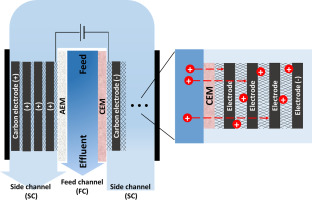Publication
Advanced Redox Technology Lab
Publication
Advanced Redox Technology Lab
Journal papers
Given the global impact of the water crisis, capacitive deionization (CDI) has attracted significant research interest as a promising water treatment technology. Recently, Multi-Channel Membrane CDI (MC-MCDI) has successfully been utilized to enhance the ion removal capacity by separating the electrode channels (side channels) from the feed stream (feed channel) to optimize the system's environment for the electrodes to perform desalination. However, one obstacle to MC-MCDI is the relatively complicated cell structure required to stack multiple units-cells. As such, the implementation of this process is limited to industrial applications. Therefore, the objectives of this study are to investigate an alternative approach and its associated parameters to expand the desalination capacity of MC-MCDI system by integrating porous carbon electrode stacks at the side channels. The MC-MCDI system with 4 pairs of carbon electrode stacks removed ~5.4 mg of NaCl and maintained the energy consumption (24 kT) and the charge efficiency close to unity. This result represents a threefold increase in the amount of ions removed, compared to a system with a single pair of carbon electrodes (~1.8 mg of NaCl). Moreover, by conducting several operation parameter studies, the MC-MCDI system with 4 pairs of porous carbon electrode stacks could be optimized at a high concentration of the supporting electrolyte (~500 mM NaCl), a faster flow rate of the feed channels, and a thinner feed channel thickness (3 mm) with high stability. In this respect, our study could advance new opportunities for the development of MC-MCDI in real-life CDI applications.
